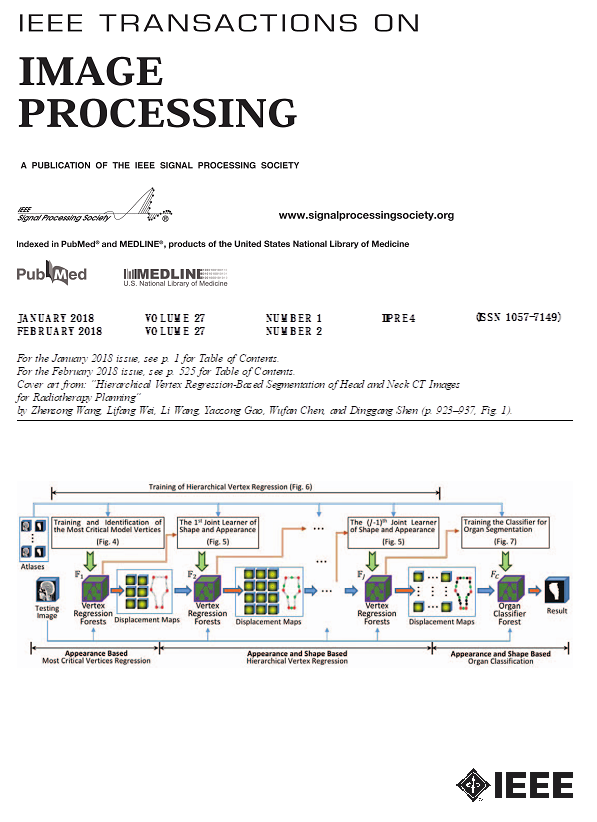基于多图谱标签融合的高阶特征学习:在MRI脑分割中的应用
IF 13.7
1区 计算机科学
Q1 COMPUTER SCIENCE, ARTIFICIAL INTELLIGENCE
引用次数: 28
摘要
基于多地图集的分割方法在大脑感兴趣区域(roi)分割中显示了其有效性,该方法是基于目标图像和多个地图集图像中的斑块之间的相似性,将多个地图集中的标签传播到目标图像中。现有的基于多图谱的方法大多采用图像强度特征来计算一对图像补丁之间的相似度进行标签融合。特别是,仅使用低水平图像强度特征不能充分表征脑磁共振(MR)图像的复杂外观模式(例如,斑块内体素之间的高阶关系)。为了解决这一问题,本文开发了一种高阶特征学习框架,用于基于多图谱的标签融合,提取和融合图像斑块的高阶特征,用于分割结构脑MR图像的roi。具体而言,采用无监督特征学习方法(即均值-协方差受限玻尔兹曼机,mcRBM)学习脑MR图像中斑块的高阶特征(即均值和协方差特征)。然后,基于学习到的高阶特征和原始图像强度特征,提出了一种组融合稀疏字典学习方法,共同计算标签融合的投票权重;并在ADNI、NIREP和LONI-LPBA40数据集上与几种最新的标签融合方法进行了比较。在ADNI、NIREP和LONI-LPBA40数据集上,我们的方法在左右海马体上获得的Dice ratio分别为88.30%、88.83%、79.54%和81.02%,而其他方法在三个数据集上获得的最佳Dice ratio分别为86.51%、87.39%、78.48%和79.65%。本文章由计算机程序翻译,如有差异,请以英文原文为准。
High-Order Feature Learning for Multi-Atlas Based Label Fusion: Application to Brain Segmentation With MRI
Multi-atlas based segmentation methods have shown their effectiveness in brain regions-of-interesting (ROIs) segmentation, by propagating labels from multiple atlases to a target image based on the similarity between patches in the target image and multiple atlas images. Most of the existing multi-atlas based methods use image intensity features to calculate the similarity between a pair of image patches for label fusion. In particular, using only low-level image intensity features cannot adequately characterize the complex appearance patterns (e.g., the high-order relationship between voxels within a patch) of brain magnetic resonance (MR) images. To address this issue, this paper develops a high-order feature learning framework for multi-atlas based label fusion, where high-order features of image patches are extracted and fused for segmenting ROIs of structural brain MR images. Specifically, an unsupervised feature learning method (i.e., means-covariances restricted Boltzmann machine, mcRBM) is employed to learn high-order features (i.e., mean and covariance features) of patches in brain MR images. Then, a group-fused sparsity dictionary learning method is proposed to jointly calculate the voting weights for label fusion, based on the learned high-order and the original image intensity features. The proposed method is compared with several state-of-the-art label fusion methods on ADNI, NIREP and LONI-LPBA40 datasets. The Dice ratio achieved by our method is 88.30%, 88.83%, 79.54% and 81.02% on left and right hippocampus on the ADNI, NIREP and LONI-LPBA40 datasets, respectively, while the best Dice ratio yielded by the other methods are 86.51%, 87.39%, 78.48% and 79.65% on three datasets, respectively.
求助全文
通过发布文献求助,成功后即可免费获取论文全文。
去求助
来源期刊

IEEE Transactions on Image Processing
工程技术-工程:电子与电气
CiteScore
20.90
自引率
6.60%
发文量
774
审稿时长
7.6 months
期刊介绍:
The IEEE Transactions on Image Processing delves into groundbreaking theories, algorithms, and structures concerning the generation, acquisition, manipulation, transmission, scrutiny, and presentation of images, video, and multidimensional signals across diverse applications. Topics span mathematical, statistical, and perceptual aspects, encompassing modeling, representation, formation, coding, filtering, enhancement, restoration, rendering, halftoning, search, and analysis of images, video, and multidimensional signals. Pertinent applications range from image and video communications to electronic imaging, biomedical imaging, image and video systems, and remote sensing.
 求助内容:
求助内容: 应助结果提醒方式:
应助结果提醒方式:


